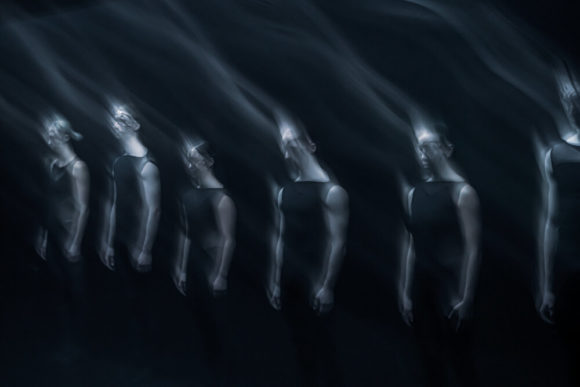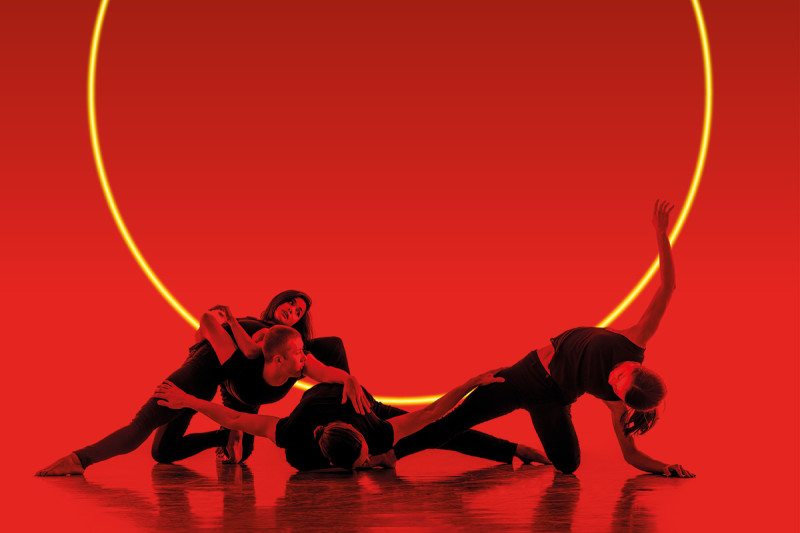Talking to choreographer Alexander Whitley for the Financial Times, 28 February 2020
On a dim and empty stage, six masked black-clad dancers, half-visible, their limbs edged in light, run through attitude after attitude, emotion after emotion. Above the dancers, a long tube of white light slowly rises, falls, tips and circles, drawing the dancers’ limbs and faces towards itself like a magnet. Under its variable cold light, movements become more expressive, more laden with emotion, more violent.
Alexander Whitley, formerly of the Royal Ballet School and the Birmingham Royal Ballet, is six years into a project to expand the staging of dance with new media. He has collaborated with filmmakers, designers, digital artists and composers. Most of all, he has played games with light.
The experiments began with The Measures Taken, in 2014. Whitley used motion-tracking technology to project visuals that interacted with the performers’ movements. Then, dissatisfied with the way the projections obscured the dancers, in 2018 he used haze and narrowly focused bars of light to create, for Strange Stranger, a virtual “maze” in which his dancers found themselves alternately liberated and constrained.
At 70 minutes Overflow, commissioned by Sadler’s Wells Theatre, represents a massive leap in ambition. With several long-time collaborators — in particular the Dutch artist-designers Children of the Light — Whitley has worked out how to reveal, to an audience sat just a few feet away, exactly what he wants them to see.
Whitley is busy nursing Overflow up to speed in time for its spring tour. The company begin with a night at the Lowry in Salford on 18 March, before performing at Sadler’s Wells on 17 and 18 April.
Overflow, nearly two years in the making, has consumed money as well as time. The company is performing at Stereolux in Nantes in April and will need more overseas bookings if it is to flourish. “There’s serious doubt about the status of the UK and UK touring companies now,” says Whitley (snapping at my cheaply dangled Brexit bait); “I hope there’s enough common will to build relationships in spite of the political situation.”
It is easy to talk politics with Whitley (he is very well read), but his dances are anything but mere vehicles for ideas. And while Overflow is a political piece by any measure — a survey of our spiritual condition under survellance capitalism, for heaven’s sake — its effects are strikingly classical. It’s not just the tricksy lighting that has me thinking of the figures on ancient Greek vases. It’s the dancers themselves and their clean, elegant, tragedian’s gestures.
A dancer kneels, and takes hold of his head. He tilts it up into the light as it turns and tilts, inches from his face, and, in a shocking piece of trompe l’ioel — can he really be pulling his face apart?
Overflow is about our relationship to the machines that increasingly govern our lives. But there’s not a hint of regimentation here, or mechanisation. These dancers are not trying to perform machine. They’re trying to perform human.
Whitley laughs at this observation. “I guess, as far as that goes, they’re over-performing human. They’re caught up in the excitement and hyper-stimulation of their activity. Which is exactly how we interact with social media. We’re being hyperstimulated into excessive activity. Keep scrolling, keep consuming, keep engaging!”
It was an earlier piece, 2016’s Pattern Recognition, that set Whitley on the road to Overflow. “I’d decided to have the lights moving around the stage, to give us the sense of depth we’d struggled to achieve in The Measures Taken. But very few people I talked to afterwards realised or understood that our mobile stage lights were being driven by real-time tracking. They thought you could achieve what we’d achieved just through choreography. At which point a really obvious insight arrived: that interactivity is interesting, first and foremost, for the actor involved in the interaction.”
In Overflow, that the audience feels left out is no longer a technical problem: it’s the whole point of the piece. “We’re all watching things we shouldn’t be watching, somehow, through social media and the internet,” says Whitley. “That the world has become so revealed is unpleasant. It’s over-exposed us to elements of human nature that should perhaps remain private. But we’re all bound up in it. Even if we’re not doing it, we’re watching it.”
The movements of the ensemble in Overflow are the equivalent of emoji: “I was interested in how we could think of human emotions just as bits of data,” Whitley explains. In the 1980s a psychologist called Robert Plutchik stated that there were eight basic emotions: joy, trust, fear, surprise, sadness, anticipation, anger, and disgust. “We stuck pins at random into this wheel chart he invented, choosing an emotion at random, and from that creating an action that somehow embodied or represented it. And the incentive was to do so as quickly and concisely as possible, and as soon it’s done, choose another one. So the dancers are literally jumping at random between all these different human emotions. It’s not real communication, just an outpouring of emotional information.”
The solos are built using material drawn from each dancer’s movement diary. “The dancers made diary entries, which I then filmed, based on how they were feeling each day. They’re movement dairies: personal documents of their emotional lives, which I then chopped up and jumbled around and gave back to them as a video to learn.”
In Whitley’s vision, the digital realm isn’t George Orwell’s Big Brother, dictating our every move from above. It’s more like the fox and the cat in the Pinnochio story, egging a naive child into the worst behaviours, all in the name of independence and free expression. “Social media encourage us to act more, to feel more, to express more, because the more we do that, the more capital they can generate from our data, and the more they can understand and predict what we’re likely to do next.”
This is where the politics comes in: the way “emotion, which incidentally is the real currency of dance, is now the major currency of the digital economy”.
It’s been a job of work, packing such cerebral content into an emotional form like dance. But Whitley says it’s what keeps him working, ” that sheer impossibility of pinning down ideas that otherwise exist almost entirely in words. As soon as you scratch the surface, you realise there’s huge amount of communication always at work through the body and drawing ideas from a more cerebral world into the physical, into the emotional, is a constant fascination. There are lifetimes of enquiry here. It’s what keeps me coming back.”



